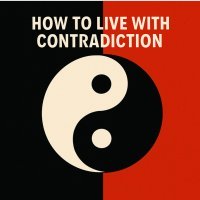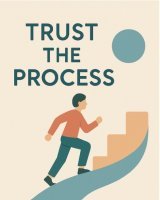Why You Need To Be Intimate With Your Own Thinking
How self-awareness and insight transforms delusion into wisdom

The Unseen Engine of Your Thoughts
We live inside an invisible weather system - one made not of clouds and wind, but of thoughts - and this invisibilty is why you need to be intimate with your own thinking.
We follow that weather through the day, shaping how we see ourselves, other people, and the world.
We might wake up to the sound of traffic and already feel behind, or replay a conversation from yesterday.
The day’s events are real enough, yet what colours them most is not what happens — but what we think about what happens.
There
comes a moment when we awaken to the fact that our thinking has a life
of its own. The mind chatters, argues, plans, compares - all without
asking our permission. And then, perhaps in a rare pause, one question
appears:
"Who is doing all this thinking, and who is watching it?"
That question marks the beginning of a new relationship with thought itself - the beginning of learning how to think, not just what to think.
Understanding the Landscape of Thought
Most of us learn early that thinking is good — the mark of intelligence, a tool for solving problems.
But few are taught how to see thought as it arises. When thought becomes invisible, it also becomes tyrannical and this is why you need to be intimate with your own thinking.
We don’t question the voice in the head that tells us we’re not doing enough, or that other people are obstacles to our peace.
This noticing - this intimacy - is what transforms thought from a master into a servant.
When we see our own mind clearly, we no longer live as its captive.
We gain a measure of inner mastery.
Wisdom Traditions and the Art of Seeing

A. The Zen Approach
In Zen practice, thought is neither glorified nor condemned. During zazen - seated meditation- thoughts come and go like birds across the sky.
The instruction is simple: don’t chase them, don’t push them away. Just sit.
Zen calls this returning to the beginner’s mind - a mind free to see, not merely to think.
This is deeply related to learning how to not think - not in the sense of suppressing thought, but no longer being ruled by it.
Zen teachers sometimes describe thought as foam on the surface of the ocean. Beneath that restless surface lies vast stillness - the mind before it splits into “me” and “my thoughts.”
B. Christian Contemplative Perspective

Christian contemplation also speaks of silence and inner watchfulness.
The Desert Fathers and Mothers - early Christian monastics who fled the distractions of the city - spoke of battling “logismoi,” the trains of thought that tempt, confuse, or ensnare the heart.
Their battle was not with flesh and blood, but with mental patterns.
Later, mystics such as the anonymous writer of "The Cloud of Unknowing" and the 16th-century Spanish Carmelite monk later known as St. John of the Cross described prayer as a surrender beyond words and concepts.
“Silence,” wrote Meister Eckhart, “is the language of God; all else is a poor translation.”
Centering prayer, a modern contemplative practice, invites the practitioner to rest in a sacred word, gently returning whenever the mind wanders.
C. Shared Ground
At the heart of both traditions lies the same paradox: you cannot see truth while trapped inside your thoughts, yet you cannot escape thought by fighting it, so this is why you need to be intimate with your own thinking.
Both Zen and Christian mysticism see thought as a veil — not an evil, but a curtain that must be drawn back to see what lies beyond.
Stillness becomes a doorway.
Freedom lies in awareness — in knowing thought as thought.
The Problem of Unexamined Thought
Why You Need To Be Intimate With Your Own Thinking
To understand why this awareness matters, we must look at what happens when thought goes unexamined.
Every human being carries invisible narratives: “I must succeed to be worthy.” “People don’t really understand me.” “The world is unsafe.”
These are not just ideas; they are filters shaping perception. The modern world, with its endless noise and stimuli, gives us little space to question them.
Psychologists call these “cognitive distortions.”
In spiritual language, they are delusions - beliefs that mask reality.
But unlike fantastical delusions, these are ordinary, daily ones.
They live in the tone of your inner voice, in the quiet despair of comparison, in the conviction that your suffering is unique.
The tragedy is not that we have delusions, but that we rarely see them as such. They blend with the texture of identity.
A Zen teacher might call this “mistaking the finger for the moon” -confusing the contents of thought for the truth they point toward.
A Christian might call it “living in the flesh” - trapped in egoic perception rather than divine awareness.
When you don’t examine these inner stories, you live inside them, which is yet another powerful reason why you need to be intimate with your own thinking.
A practice like journaling can help expose these inner narratives.
Cultivating Intimacy With Your Mind
In order to be able to address the question of why you need to be intimate with your own thinking we need first to understand what it means to become intimate with your own thinking
- It begins with curiosity rather than control.
- Most of us treat our thoughts like unruly children to be silenced or disciplined.
- But intimacy suggests friendship - knowing the quirks, the patterns, the moods of the mind.
To be intimate with thinking is to say: "Ah, there you are again, anxiety. I see you." Or, "Hello, ambition - I know what you’re trying to protect."
Mindfulness, in this sense, is not self-improvement but self-acquaintance.
- It is the art of being on familiar terms with our own consciousness.
- We learn the terrain of our thoughts as a traveler learns a landscape - by walking it, patiently, again and again.
In Zen, such intimacy dissolves the illusion of separation between observer and observed.
In Christian contemplation, it opens the heart to grace.
In both, it reveals that awareness itself is untouched by the storms that pass through it.
Transformation - When Delusion Becomes Ground for Insight
Why You Need To Be Intimate With Your Own Thinking
There’s a paradox here: as we become more aware of our delusions, they do not vanish overnight.
We still get angry, afraid, or self-righteous.
The difference is that now we see them. And in that seeing, something softens.
The Zen masters often tell of enlightenment moments arising not in purity, but in failure — a monk dropping a water bucket, a teacher struck by a pebble, a disciple realizing the futility of striving.
The moment of awakening often comes through the very texture of delusion itself, when the mind stops fleeing its own confusion and simply sees it as it is.
Similarly, St. Augustine’s famous confession — “Our hearts are restless until they rest in Thee” — emerged not from holiness, but from deep recognition of his own restless thought patterns.
His delusions became the soil from which insight grew.
Thinking as a Modern Skill
Outside monasteries and meditation halls, how does this look in daily life?
In the modern world, thinking is both our greatest tool and our greatest trap. We have made external thinking - analysis, planning, argument -into a professional virtue, while neglecting the inner art of thinking about thinking.
The result is mental overproduction without self-awareness. This is a major reason why you need to be intimate with your thoughts.
Here are some simple ways this can unfold:
- Journaling: Writing down recurring thoughts externalizes them. Once on paper, their emotional weight often lessens, and patterns become visible.
- Silence: Deliberately limit input - 30 minutes a day without screens or music. In silence, the mind reveals its default setting.
- Pausing: Before reacting - to an email, a comment, a frustration - breathe once. That single breath often saves a hundred regrets.
- Inquiry: When upset, ask: What story am I telling myself right now? Naming the story often weakens its spell.
These are not mystical techniques but mental hygiene.
Just as we clean our homes, we can learn to air out the mind.
From Earth to Light

The work of becoming intimate with thought is not glamorous. It involves sitting quietly with restlessness, boredom, and confusion. It asks us to meet ourselves without pretense. But this humility is the birthplace of all genuine insight.
- Over time, as we see our thoughts clearly, we begin to recognize something luminous within them.
- Even our delusions — those stubborn, painful beliefs — become the very material of awakening.
- The same mind that creates confusion also holds the capacity for wisdom.
- The mind’s darkness is not a failure but a field. Awareness does not reject it; it illuminates it.
- The same soil that grows weeds can, when tended, blossom into clarity.
And so we return to the teaching that has silently underpinned all these reflections:
Reflections and Actions

The journey toward awareness is not a flight from imperfection but a deeper acceptance of what is.
- Thought, when seen clearly, reveals its dual nature: it can deceive, but it can also point the way home.
- The key is intimacy — knowing the mind as one knows a friend, through patient attention and gentle honesty.
- This intimacy transforms delusion into wisdom.
- The more we understand our own inner weather, the less we are driven by its storms.
Both Zen and Christian contemplation remind us that peace is not found beyond thought, but within the clear seeing of it.
Points for Reflection and Practice
# Daily Awareness:
- Each morning, notice the first thought that arises. Don’t judge it; simply observe it. This sets a tone of awareness for the day.
# Micro-Pauses:
- Before responding to messages, conversations, or impulses, take a single mindful breath. That breath creates space between thought and action.
# Silent Practice:
- Sit for five minutes in stillness. Let thoughts come and go. The goal is not to stop them but to witness them.
# Journaling Prompt:
- Write, “The story I’m believing right now is…” and complete the sentence without censoring. Notice recurring themes over time.
# Contemplative Question:
- “What am I afraid to see in myself?” Approach the answer not as accusation but as invitation.
# Koan or Scripture Meditation:
- Choose a short phrase — a Zen koan, a line of scripture, or a sacred saying — and hold it gently in mind during the day. Let it reflect your thinking back to you.
# Community Practice:
- Share your observations with a trusted friend or group. Speaking thoughts aloud can reveal their transparency and soften their grip.
# Acts of Stillness in Motion:
- Practice awareness while walking, washing dishes, or driving. Notice how thought arises and passes through these ordinary moments.
# Self-Compassion:
- When you catch yourself lost in thought, smile. The noticing itself is success. Awareness begins not in perfection but in kindness.
Closing Reflection
To
know one’s thoughts is to walk barefoot on the soil of one’s own being. Every step reveals stones, weeds, and soft earth alike. But in that
contact - that intimacy - we find the ground of transformation. The
delusions that once obscured the sky become, with awareness, the very
earth that supports it. And when the night of confusion comes, we
may look up and find that something gentle and luminous has been shining
there all along - the clear light of awareness itself, reflected in the
quiet moon of understanding.
Return from: "Why You Need To Be Intimate With Your Own Thinking" to: Inner Mastery For Outer Impact or The Wise Advocate
Next Article: The Battle For Your Mind - How To Win Inner Freedom In A Digital Age
LATEST ARTICLES
Site Pathways
 Here is a site pathway to help new readers of Zen-Tools navigate the material on this site. Each pathway is based around one of the many key themes covered on this site and contain a 150 word introduc…
Here is a site pathway to help new readers of Zen-Tools navigate the material on this site. Each pathway is based around one of the many key themes covered on this site and contain a 150 word introduc…How To Live With Contradiction - Beyond Thought Let Stillness Speak
 A major impact on so many peoples' lives is the situational contradiction of unfilled realistic expectations. So where does all this leave us? Well here we are, with mental equipment that is more lim…
A major impact on so many peoples' lives is the situational contradiction of unfilled realistic expectations. So where does all this leave us? Well here we are, with mental equipment that is more lim…How To Trust The Process Of Mindfulness - Right Now
 In mindfulness, the process isn’t some distant goal — it's what is happening right now. When we talk about how to trust the process of mindfulness the credibility of the process is heavily dependent…
In mindfulness, the process isn’t some distant goal — it's what is happening right now. When we talk about how to trust the process of mindfulness the credibility of the process is heavily dependent…Inner Mastery For Outer Impact - Mental Clarity For Effective Action
 Insights only matter if they translate into consistent action. In a world crowded with quick fixes and motivational soundbites, the theme “Inner Mastery for Outer Impact” calls us to something more e…
Insights only matter if they translate into consistent action. In a world crowded with quick fixes and motivational soundbites, the theme “Inner Mastery for Outer Impact” calls us to something more e…The Wise Advocate - Helping You Achieve The Very Best Outcome
 The focus of your attention in critical moments of choice either builds or restricts your capacity for achieving the best outcome. When we talk of 'The Wise Advocate' its easy to think of the consigl…
The focus of your attention in critical moments of choice either builds or restricts your capacity for achieving the best outcome. When we talk of 'The Wise Advocate' its easy to think of the consigl…Trust The Process - Beyond The Cliche
 The phrase "trust the process" has become a cliche, the woo-woo mantra of the "self help" industry. Those three little words feel like they ought to mean something useful but hidden behind them are a…
The phrase "trust the process" has become a cliche, the woo-woo mantra of the "self help" industry. Those three little words feel like they ought to mean something useful but hidden behind them are a…The Dopamine Delusion - Why Anticipation Beats Achievement
 The thrill we feel is not in the having, but in the wanting. The more we have, the more we want. The more things we acquire and the easier things get for us, the more discontent we feel. The more spo…
The thrill we feel is not in the having, but in the wanting. The more we have, the more we want. The more things we acquire and the easier things get for us, the more discontent we feel. The more spo…The Power Of Silence Is Experienced In Your Use Of Language
 Practise the "Beneficial Neurological Delay" for optimal comprehension. The power of silence is experienced in your use of language, specifically: - How you formulate the words you use to think and in…
Practise the "Beneficial Neurological Delay" for optimal comprehension. The power of silence is experienced in your use of language, specifically: - How you formulate the words you use to think and in…Dealing With Setbacks - 5 Questions To Help You Face Discomfort
 How To Counter The Cognitive Shock Of A Setback. Setbacks challenge your instinctual desire for control and comfort, making it unnatural to respond with calm or acceptance. The reason for these instin…
How To Counter The Cognitive Shock Of A Setback. Setbacks challenge your instinctual desire for control and comfort, making it unnatural to respond with calm or acceptance. The reason for these instin…Why Praxis Is The Key To Living A Successful And Stress Free Life
 Praxis Is The Process Of Taking Informed Action To take informed action you need to be prepared with information, knowledge, education and insight. Informed action is objective action that: - Seeks to…
Praxis Is The Process Of Taking Informed Action To take informed action you need to be prepared with information, knowledge, education and insight. Informed action is objective action that: - Seeks to…The Power Of Working With The Front Line
 How To Exercise Influence Without Authority In Complex Systems I first discovered the power of working with the frontline when I was working as a business troubleshooter on large projects, programmes…
How To Exercise Influence Without Authority In Complex Systems I first discovered the power of working with the frontline when I was working as a business troubleshooter on large projects, programmes…Dealing With Distraction - Learning How To Live With Your "Attention Autopilot"
 Living With Your Attention Autopilot The good news about your Attention Autopilot is that it will keep you safe. It is continuously scanning your immediate environment for threats. The bad news is tha…
Living With Your Attention Autopilot The good news about your Attention Autopilot is that it will keep you safe. It is continuously scanning your immediate environment for threats. The bad news is tha…



